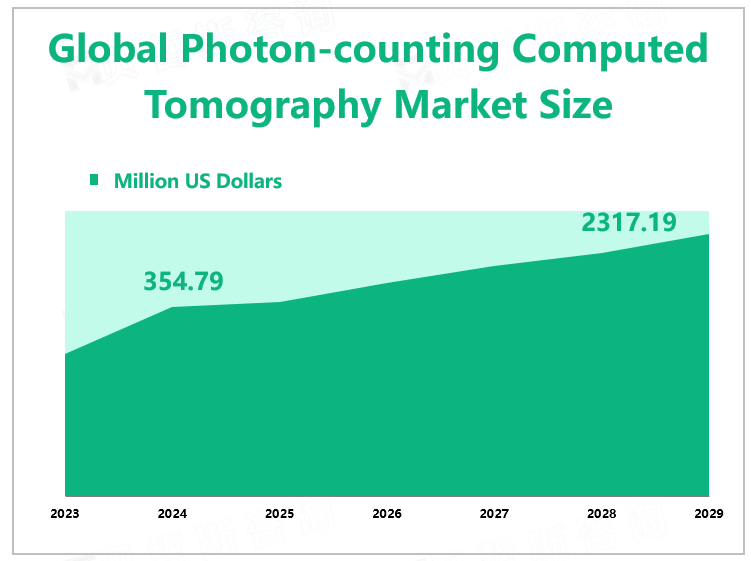Global Photon-counting Computed Tomography Market Overview
According to Global Market Monitor, the global photon-counting computed tomography market size is $354.79 million in 2024 and is expected to grow to $2317.19 million by 2029.
Photon-counting computed tomography (PCCT) is an emerging technology in CT, which could represent the next major technological milestone in the field. Photon-counting computed tomography (PCCT) is a form of X-ray computed tomography (CT) in which X-rays are detected using a photon-counting detector (PCD). The first clinically-approved PCCT system was cleared by the Food and Drug Administration (FDA) in September 2021.This technology has many advantages, such as zero dark noise, high depth of image grayscale, large dynamic range, low radiation dose required for imaging, and multi-spectral images.
Siemens
Siemens aims to scan 1 billion patients using photon count-based computed tomography scanners over the next decade, enabling its unique, state-of-the-art imaging technology to reach a growing number of communities. So far, more than 500,000 patients have been scanned at large installations ranging from private clinics to large university hospitals, each with its unique mix of clinical cases. Especially in the heart field, the new cardiac imaging reconstruction enables the heart imager to obtain consistent results for various detector widths.

The Application Prospect of Photon-Counting Computed Topography is Broad.
In recent years, photon counting technology has set off an upsurge in medical application research and development. As the globally recognized next-generation X-ray imaging technology, Photon-Counting Computed Tomography uses high-speed ASIC to count X-ray photons one by one, instead of converting X-ray to visible light by the scintillator, X-ray photons are directly converted into electric pulses in the dielectric layer. Therefore, it has no crosstalk problem in traditional indirect detectors, and the images' spatial resolution and density resolution have been greatly improved. These technical advantages perfectly match the high-performance requirements of future medical imaging equipment, and have great potential in digital dentistry, breast, CT, nuclear medicine, molecular imaging, ultra-low radiation dose interventional imaging, and other equipment, representing the development trend of future imaging technology.
Although photon counting detector has many advantages, there are still some problems to be solved, such as charge sharing and charge accumulation. In the future, with the progress of manufacturing technology and electronic technology, the performance of photon counting detectors will be further improved, and the overall performance of CT equipment will reach a higher level.
Market Challenges
Currently, the technology is only in the hands of a few manufacturers, because the photon-counting computed tomography equipment involves the research and development of top-notch photon-counting computed tomography and the production of high-end manufacturing industry.
At the same time, in the process of equipment development, there are no ready-made standards and experiences to follow in design, processing, assembly, and testing. The machining difficulty of key devices is beyond imagination. This has greatly hindered new entrants from entering the market, resulting in a high market concentration in the Photon-Counting Computed Tomography industry, and the key technologies are controlled by a few manufacturers.
This new type of equipment will also bring new challenges. Firstly, it is more expensive than traditional CT equipment. The core of Photon-Counting Computed Tomography is the detector part, which is also the most expensive part. Its high price will limit its popularity.
|
Drivers |
Photon-counting computed tomography is the most advanced version of CT |
|
The application prospect of photon counting computed topography is broad |
|
|
Medical market demand |
|
|
Manufacturers actively lay out the field of photon-counting computed tomography |
We provide more professional and intelligent market reports to complement your business decisions.